Page 212 of 360
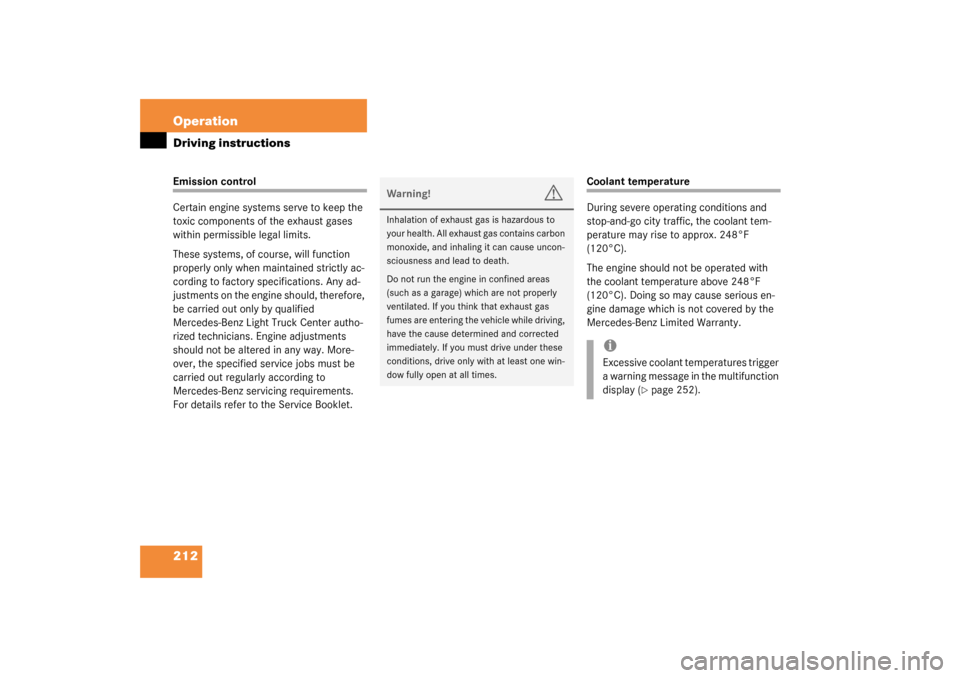
212 OperationDriving instructionsEmission control
Certain engine systems serve to keep the
toxic components of the exhaust gases
within permissible legal limits.
These systems, of course, will function
properly only when maintained strictly ac-
cording to factory specifications. Any ad-
justments on the engine should, therefore,
be carried out only by qualified
Mercedes-Benz Light Truck Center autho-
rized technicians. Engine adjustments
should not be altered in any way. More-
over, the specified service jobs must be
carried out regularly according to
Mercedes-Benz servicing requirements.
For details refer to the Service Booklet.
Coolant temperature
During severe operating conditions and
stop-and-go city traffic, the coolant tem-
perature may rise to approx. 248°F
(120°C).
The engine should not be operated with
the coolant temperature above 248°F
(120°C). Doing so may cause serious en-
gine damage which is not covered by the
Mercedes-Benz Limited Warranty.
Warning!
G
Inhalation of exhaust gas is hazardous to
your health. All exhaust gas contains carbon
monoxide, and inhaling it can cause uncon-
sciousness and lead to death.
Do not run the engine in confined areas
(such as a garage) which are not properly
ventilated. If you think that exhaust gas
fumes are entering the vehicle while driving,
have the cause determined and corrected
immediately. If you must drive under these
conditions, drive only with at least one win-
dow fully open at all times.
iExcessive coolant temperatures trigger
a warning message in the multifunction
display (
�page 252).
Page 215 of 360
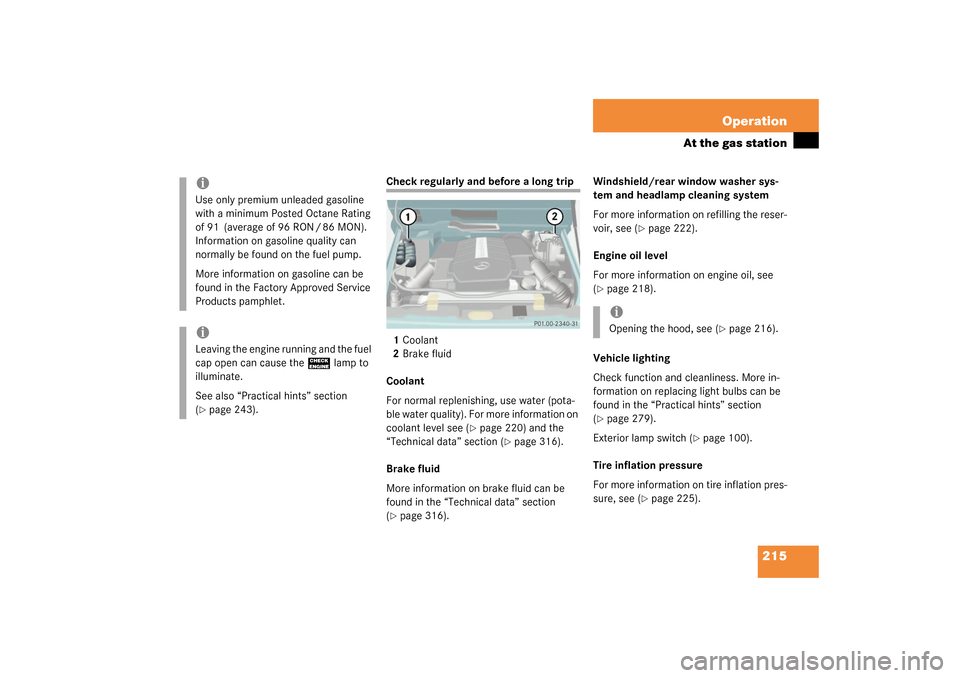
215 Operation
At the gas station
Check regularly and before a long trip
1Coolant
2Brake fluid
Coolant
For normal replenishing, use water (pota-
ble water quality). For more information on
coolant level see (
�page 220) and the
“Technical data” section (
�page 316).
Brake fluid
More information on brake fluid can be
found in the “Technical data” section
(
�page 316).Windshield/rear window washer sys-
tem and headlamp cleaning system
For more information on refilling the reser-
voir, see (
�page 222).
Engine oil level
For more information on engine oil, see
(
�page 218).
Vehicle lighting
Check function and cleanliness. More in-
formation on replacing light bulbs can be
found in the “Practical hints” section
(�page 279).
Exterior lamp switch (
�page 100).
Tire inflation pressure
For more information on tire inflation pres-
sure, see (
�page 225).
iUse only premium unleaded gasoline
with a minimum Posted Octane Rating
of 91 (average of 96 RON / 86 MON).
Information on gasoline quality can
normally be found on the fuel pump.
More information on gasoline can be
found in the Factory Approved Service
Products pamphlet. iLeaving the engine running and the fuel
cap open can cause the
?
lamp to
illuminate.
See also “Practical hints” section
(
�page 243).
iOpening the hood, see (
�page 216).
Page 216 of 360
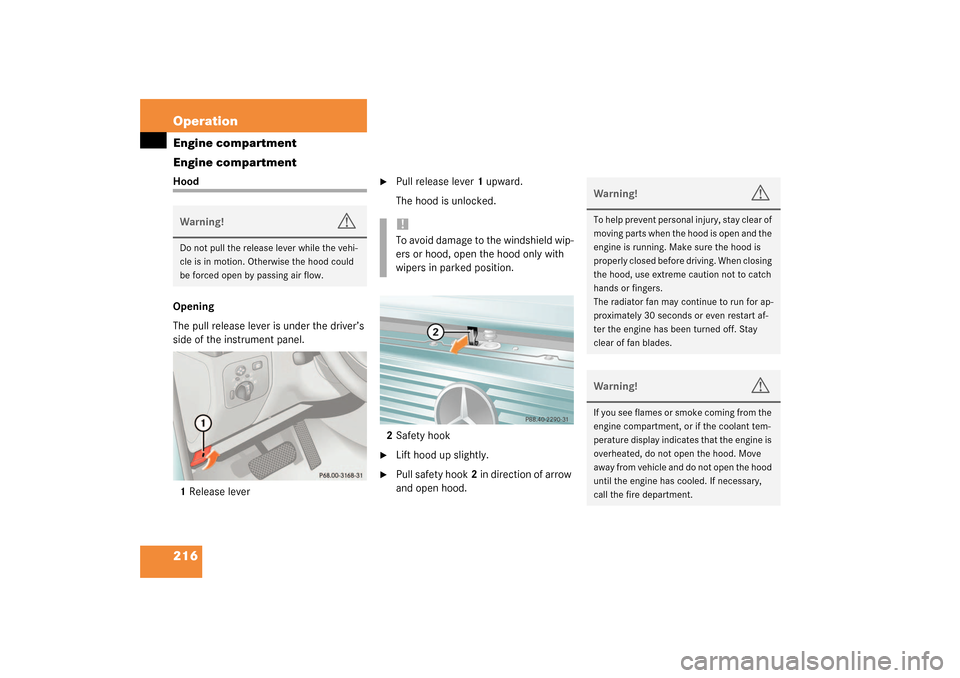
216 OperationEngine compartment
Engine compartmentHood
Opening
The pull release lever is under the driver’s
side of the instrument panel.
1Release lever
�
Pull release lever1 upward.
The hood is unlocked.
2Safety hook
�
Lift hood up slightly.
�
Pull safety hook2 in direction of arrow
and open hood.
Warning!
G
Do not pull the release lever while the vehi-
cle is in motion. Otherwise the hood could
be forced open by passing air flow.
!To avoid damage to the windshield wip-
ers or hood, open the hood only with
wipers in parked position.
Warning!
G
To help prevent personal injury, stay clear of
moving parts when the hood is open and the
engine is running. Make sure the hood is
properly closed before driving. When closing
the hood, use extreme caution not to catch
hands or fingers.
The radiator fan may continue to run for ap-
proximately 30 seconds or even restart af-
ter the engine has been turned off. Stay
clear of fan blades.Warning!
G
If you see flames or smoke coming from the
engine compartment, or if the coolant tem-
perature display indicates that the engine is
overheated, do not open the hood. Move
away from vehicle and do not open the hood
until the engine has cooled. If necessary,
call the fire department.
Page 220 of 360
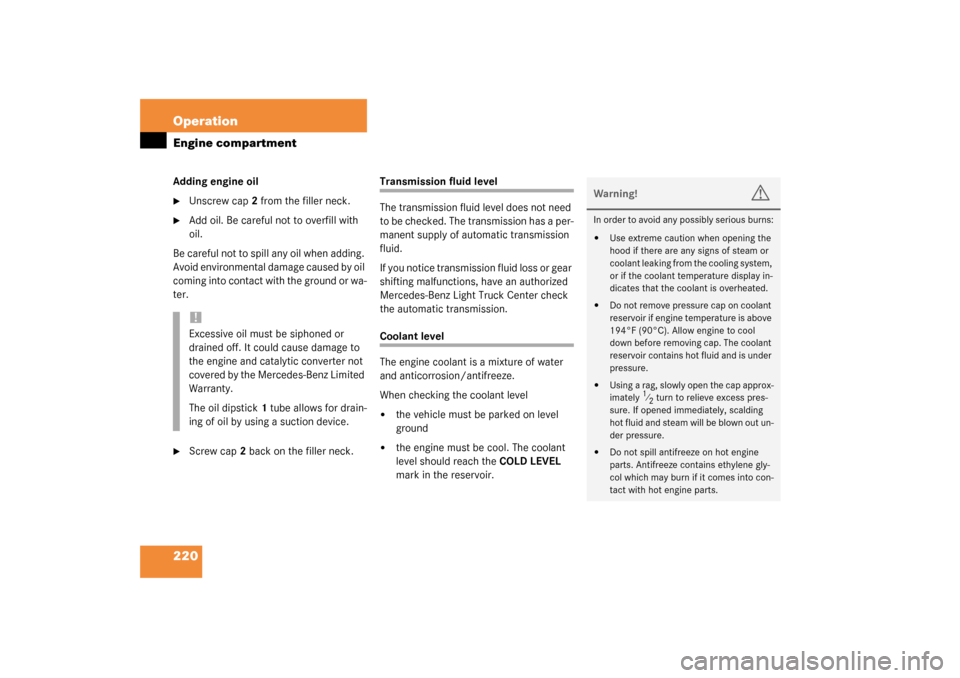
220 OperationEngine compartmentAdding engine oil�
Unscrew cap2 from the filler neck.
�
Add oil. Be careful not to overfill with
oil.
Be careful not to spill any oil when adding.
Avoid environmental damage caused by oil
coming into contact with the ground or wa-
ter.
�
Screw cap2 back on the filler neck.
Transmission fluid level
The transmission fluid level does not need
to be checked. The transmission has a per-
manent supply of automatic transmission
fluid.
If you notice transmission fluid loss or gear
shifting malfunctions, have an authorized
Mercedes-Benz Light Truck Center check
the automatic transmission.Coolant level
The engine coolant is a mixture of water
and anticorrosion/antifreeze.
When checking the coolant level �
the vehicle must be parked on level
ground
�
the engine must be cool. The coolant
level should reach the COLD LEVEL
mark in the reservoir.
!Excessive oil must be siphoned or
drained off. It could cause damage to
the engine and catalytic converter not
covered by the Mercedes-Benz Limited
Warranty.
The oil dipstick1 tube allows for drain-
ing of oil by using a suction device.
Warning!
G
In order to avoid any possibly serious burns:�
Use extreme caution when opening the
hood if there are any signs of steam or
coolant leaking from the cooling system,
or if the coolant temperature display in-
dicates that the coolant is overheated.
�
Do not remove pressure cap on coolant
reservoir if engine temperature is above
194°F (90°C). Allow engine to cool
down before removing cap. The coolant
reservoir contains hot fluid and is under
pressure.
�
Using a rag, slowly open the cap approx-
imately
1⁄2turn to relieve excess pres-
sure. If opened immediately, scalding
hot fluid and steam will be blown out un-
der pressure.
�
Do not spill antifreeze on hot engine
parts. Antifreeze contains ethylene gly-
col which may burn if it comes into con-
tact with hot engine parts.
Page 221 of 360
221 Operation
Engine compartment
The coolant expansion tank is located on
the passenger side of the engine compart-
ment.
1Cap
�
Using a rag, turn the cap slowly approx-
imately one half turn to the left to re-
lease any excess pressure.
�
Continue turning the cap to the left and
remove it.
�
Check coolant level.
The coolant level is correct if the level �
for cold coolant: is level with the
mark on the reservoir
�
for warm coolant: is approx. 0.6 in
(1.5 cm) higher
�
Add coolant as required.
�
Replace and tighten cap until you hear
it click a few times. If coolant has to be added, a 50 / 50 mix-
ture of water and
MB Anticorrosion /Antifreeze should be
added.
More information on coolant can be found
in the “Technical data” section
(
�page 316).
Page 232 of 360
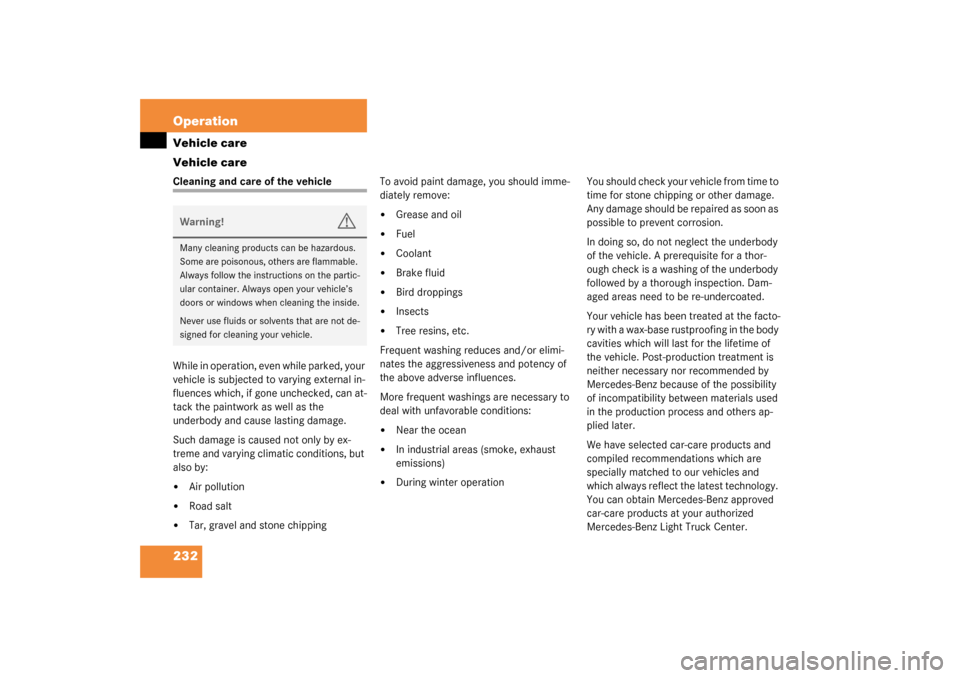
232 OperationVehicle care
Vehicle careCleaning and care of the vehicle
While in operation, even while parked, your
vehicle is subjected to varying external in-
fluences which, if gone unchecked, can at-
tack the paintwork as well as the
underbody and cause lasting damage.
Such damage is caused not only by ex-
treme and varying climatic conditions, but
also by:�
Air pollution
�
Road salt
�
Tar, gravel and stone chippingTo avoid paint damage, you should imme-
diately remove:
�
Grease and oil
�
Fuel
�
Coolant
�
Brake fluid
�
Bird droppings
�
Insects
�
Tree resins, etc.
Frequent washing reduces and/or elimi-
nates the aggressiveness and potency of
the above adverse influences.
More frequent washings are necessary to
deal with unfavorable conditions:
�
Near the ocean
�
In industrial areas (smoke, exhaust
emissions)
�
During winter operationYou should check your vehicle from time to
time for stone chipping or other damage.
Any damage should be repaired as soon as
possible to prevent corrosion.
In doing so, do not neglect the underbody
of the vehicle. A prerequisite for a thor-
ough check is a washing of the underbody
followed by a thorough inspection. Dam-
aged areas need to be re-undercoated.
Your vehicle has been treated at the facto-
ry with a wax-base rustproofing in the body
cavities which will last for the lifetime of
the vehicle. Post-production treatment is
neither necessary nor recommended by
Mercedes-Benz because of the possibility
of incompatibility between materials used
in the production process and others ap-
plied later.
We have selected car-care products and
compiled recommendations which are
specially matched to our vehicles and
which always reflect the latest technology.
You can obtain Mercedes-Benz approved
car-care products at your authorized
Mercedes-Benz Light Truck Center.
Warning!
G
Many cleaning products can be hazardous.
Some are poisonous, others are flammable.
Always follow the instructions on the partic-
ular container. Always open your vehicle’s
doors or windows when cleaning the inside.
Never use fluids or solvents that are not de-
signed for cleaning your vehicle.
Page 251 of 360
251 Practical hints
What to do if …
Display
Possible cause
Suggested solution
Category
B
COOLANT
CHECK LEVEL!
The coolant level is too low.
�
Add coolant (
�page 220).
�
If you have to add coolant fre-
quently, have the cooling sys-
tem checked by an authorized
Mercedes-Benz Light Truck
Center.
2
Warning!
G
Do not spill antifreeze on hot engine parts.
Antifreeze contains ethylene glycol which
may burn if it comes into contact with hot
engine parts. You can be seriously burned.
!Do not ignore the low engine coolant
level warning. Extended driving with
the message and symbol displayed
may cause serious engine damage not
covered by the Mercedes-Benz Limited
Warranty.
Do not drive without sufficient amount
of coolant in the cooling system. The
engine will overheat causing serious
engine damage.
Observe the coolant temperature dis-
play (
�page 108).
Page 252 of 360
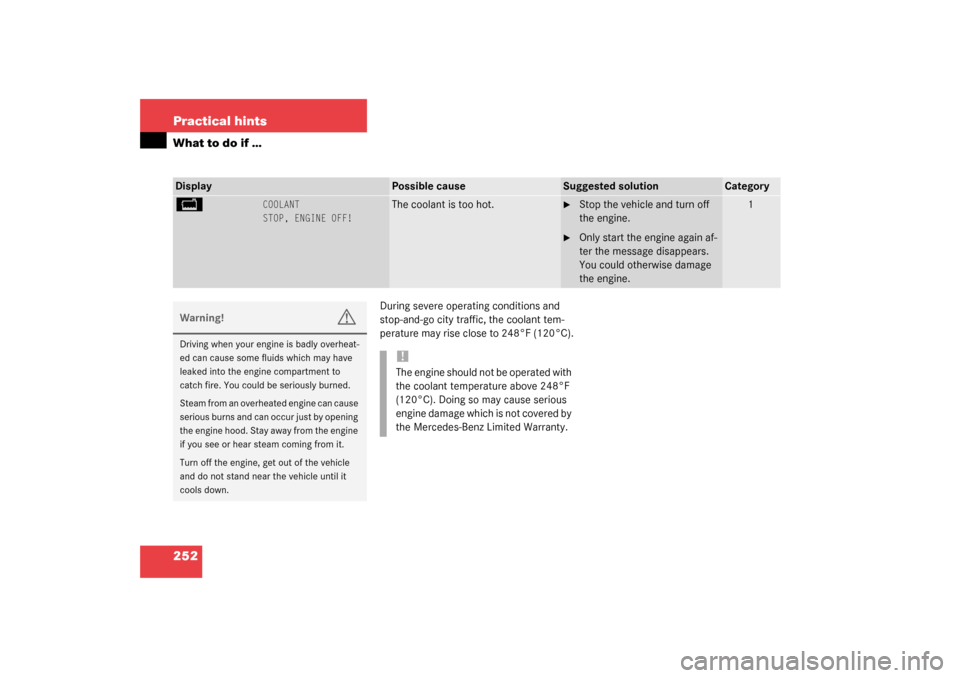
252 Practical hintsWhat to do if …
During severe operating conditions and
stop-and-go city traffic, the coolant tem-
perature may rise close to 248°F (120°C).
Display
Possible cause
Suggested solution
Category
B
COOLANT
STOP, ENGINE OFF!
The coolant is too hot.
�
Stop the vehicle and turn off
the engine.
�
Only start the engine again af-
ter the message disappears.
You could otherwise damage
the engine.
1
Warning!
G
Driving when your engine is badly overheat-
ed can cause some fluids which may have
leaked into the engine compartment to
catch fire. You could be seriously burned.
Steam from an overheated engine can cause
serious burns and can occur just by opening
the engine hood. Stay away from the engine
if you see or hear steam coming from it.
Turn off the engine, get out of the vehicle
and do not stand near the vehicle until it
cools down.
!The engine should not be operated with
the coolant temperature above 248°F
(120°C). Doing so may cause serious
engine damage which is not covered by
the Mercedes-Benz Limited Warranty.